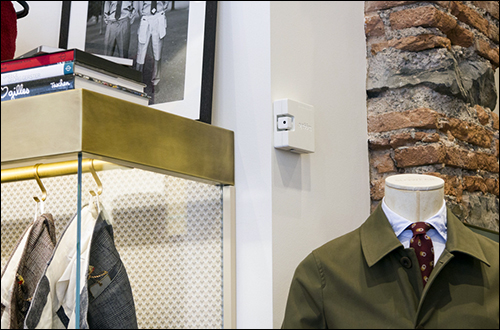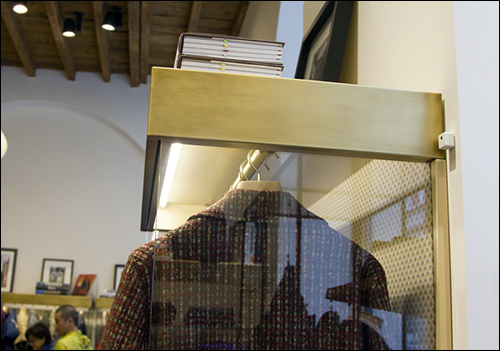Taggalo, an Italian startup that formed as a spinoff of Italy’s National Research Council (CNR), a governmental body that supports scientific and technological research, launched its eponymous product last week. The Taggalo unit—which combines a video camera, a Bluetooth beacon and a Wi-Fi radio into a 4-inch-square, 2-inch-thick device—is marketed, along with a companion data-analytics service, as a means for retailers to collect a wide range of data related to their customers.
The company is one of 12 startups selected for the Challenge Up Internet of Things accelerator program sponsored by Cisco, Deutsche Telekom and Intel. The program aims to stoke innovation among early-stage companies developing IoT technologies or IoT-based solutions.
The Wi-Fi radio in the Taggalo device collects the media access control (MAC) address being transmitted by a customer’s smartphone when she or he walks into the store (assuming the phone’s Wi-Fi modem is turned on) as a means of tracking new versus returning guests. The unit’s software records the length of time that each visitor stays within a Taggalo device’s Wi-Fi range. Taggalo employs the SHA-2 hashing standard to encrypt the MAC addresses it stores. When a shopper returns to the store, the device can then use this hashing function to match the MAC address to the encrypted version in its database. (Shoppers can opt out of this data collection by turning off the Wi-Fi functions on their phone, the company notes, or by sending an email request to Taggalo.)
The Taggalo device’s camera takes video images of every shopper within its range. The software scans the video imagery and uses morphologic facial analysis to estimate each individual’s gender, age and race as he or she moves through the store. The software then indexes this information based on store location, as well as by date and time. Taggalo suggests that retailers place one Taggalo device near the front door to capture video of shoppers walking past the store, another to capture customers moving into the building and a third inside the store.
Taggalo stores the demographic data it derives from analysis—e.g., male, Caucasian, 40 years old—for 24 months. The Taggalo device analyzes the video in real time and does not save images of shoppers on the device or in the cloud.
The Bluetooth beacon inside the device can be used to ping the smartphones of shoppers who have downloaded the store’s app onto their phones, which then would advertise special offers through push notifications as they shop. Taggalo offers a service to white-label and manage smartphone apps for its customers.
Retailers can access the shopper-analytics data in real time via a Web-based dashboard. In addition, they can access the raw data in order to integrate it into any in-house analytics software platform it already uses.
Paolo Guida, one of Taggalo’s co-founders, as well as an investor in the company, says retailers can use the Taggalo device in a number of ways to better understand not just shopper demographics, how often patrons return and how long they remain in the store, but also such factors as the effectiveness of discounts offered through a smartphone app. He adds that retailers can look for demographic data over time to determine the best times of day or days of the week to run special offers for products, based on the demographics of the shoppers likely to be in the store at any given time.
The Taggalo unit is not self-powered. It must be wired into a building’s main power. The video camera module can be extended from the main body of the device and mounted at the edge of a shelf, for example, with its wiring strung along the shelf and then snaked into a wall, behind which the rest of the unit can be mounted. In this way, the Wi-Fi and beacon are functional but are not visible.
Each Taggalo unit costs $250, Guida says, and pricing for the companion data-analytics services starts at $40 per month.
Early User
Altromercato, a cooperative of food, apparel and housewares stores specializing in fair-trade goods from around the world, is an early tester of the Taggalo device. Andrea Monti, the company’s general manager, says the units have been installed in two of Altromercato’s 300 stores throughout Italy, and he plans to add them to eight more locations by this coming summer.
“We are making major changes to all of our locations,” Monti says, “and we are looking for something to measure changes as we’re making them.” Those changes include relocating product categories around the store as necessary. Monti expects that the insights he gains from the video analysis provided by Taggalo will help store managers decide optimal product placements, based on the correlation between a particular items’ placements, the demographics of shoppers who browse them and the store sales.
“I want to know which kind of customer is buying food, hand crafts or fashion,” Monti states. “We are planning on putting a few devices in different locations, so visually, this will tell me if we get male or female, young or older, shoppers [in those locations within the store].”
The company’s goal in deploying Taggalo devices, Monti explains, is to empower store managers to understand the best locations for specific goods (in order to improve sales of those products) and also to streamline each store’s inventory. Store managers could obtain similar insights from analyzing sales data, but Monti thinks the details they get from Taggalo will enable them to optimize product placement more quickly and accurately than they could by adjusting planograms based only on sales numbers. With so many store locations and so many types of products offered, he says, the stores tend to hold a great deal of inventory. Eventually, he would like the stores to reduce the number of stock-keeping units at each store, and to better estimate which products to stock based on the demographics and buying habits of the shoppers who frequent specific locations.



